Priority & Endangered Species (Fauna)
Loggerhead Turtle (Caretta caretta)
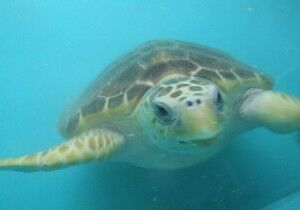 Sea Turtles appeared during the Triassic Period, 245 to 208 million years ago. They are cold blooded reptiles and, together with saltwater crocodiles, marine snakes, and marine iguanas, are the only surviving seawater-adapted reptiles. They have lungs similar to those of mammals and therefore need to surface for air. The Sea Turtle does not have teeth, but a beak-like jaw to match its diet of fish, jellyfish and crustaceans. They also drink seawater and remove the extra salt from their body as tears. Being cold-blooded animals, sea turtles cannot regulate their body temperature and therefore need to adapt to the temperature of their surrounding environment. This is why they love warm waters, basking lazily in the sun just below the water’s surface. The Sea Turtle has a long life span, reaching maturity at around 35 years of age.
Sea Turtles appeared during the Triassic Period, 245 to 208 million years ago. They are cold blooded reptiles and, together with saltwater crocodiles, marine snakes, and marine iguanas, are the only surviving seawater-adapted reptiles. They have lungs similar to those of mammals and therefore need to surface for air. The Sea Turtle does not have teeth, but a beak-like jaw to match its diet of fish, jellyfish and crustaceans. They also drink seawater and remove the extra salt from their body as tears. Being cold-blooded animals, sea turtles cannot regulate their body temperature and therefore need to adapt to the temperature of their surrounding environment. This is why they love warm waters, basking lazily in the sun just below the water’s surface. The Sea Turtle has a long life span, reaching maturity at around 35 years of age.
Sea Turtle numbers are on the decline for various reasons. These include :
• accidental trapping and entanglement in fishermen’s long lines and nets;
• getting caught on hooks while eating fishing bait (the hooks and lines cause infections that may lead to a cruel death);
• ingestion of plastics bags, (eaten by Sea Turtles who mistake them for jellyfish);
• strikes from boat propellers;
• coastal development and destruction of nesting beaches;
• destruction of feeding habitats such as seagrass meadows as a result of destructive fishing techniques, sedimentation, nutrient runoff from the land, insensitive touristic development and climate change;
• decline of prey population for similar reasons.
Maltese Freshwater Crab (Potamon fluviatile ssp. lanfrancoi)
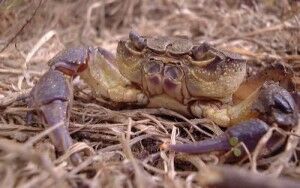 The Maltese Freshwater Crab (MT: Qabru) is endemic to certain areas within the Maltese Islands and is found at Bahrija, Mtahleb, San Martin and Lunzjata Valley (Gozo), where running water is present all year round. Protected by law, this subspecies of crab is very rare and its numbers have been decreasing in recent years due to drying up or pollution of the springs it lives in or also capture by humans.
The Maltese Freshwater Crab (MT: Qabru) is endemic to certain areas within the Maltese Islands and is found at Bahrija, Mtahleb, San Martin and Lunzjata Valley (Gozo), where running water is present all year round. Protected by law, this subspecies of crab is very rare and its numbers have been decreasing in recent years due to drying up or pollution of the springs it lives in or also capture by humans.
It grows up to 7-8cm and lives near pools and springs and hides under stones in the water, among vegetation, or by retreating into burrows which it excavates in the mud or clay. It is a carnivorous organism and usually feeds after sunset on smaller animals including snails and tadpoles.
Maltese Wall Lizard (Podarcis filfolensis)
The Maltese Wall Lizard (MT: Gremxula ta’ Malta) and its four subspecies are endemic to the Maltese Islands. Its natural habitats are Mediterranean-type shrubby vegetation, rocky areas, rocky shores, arable land, pastureland, and rural gardens. Unlike the males, who have bright colours, young lizards and females have somewhat dull coloration (brownish). Males show territorial behaviour. When other males enter its territory, it puffs up and raises its head. A similar behaviour is seen when they attract females. Mating takes place in spring. One or two eggs are laid shortly after, and finally hatch between June and mid-August.
Podarcis filfolensis ssp. maltensis is a subspecies found on the three main islands of Malta, Gozo and Comino. It is normally greenish and sometimes speckled.
Podarcis filfolensis ssp. filfolensis is endemic only to the islet of Filfla and is the largest of the four subspecies and is blackish with bluish spots.
Podarcis filfolensis ssp. kieselbachi is a lizard with a large variety of colours, from brown to grey, but always with an orange belly and small black spots. Some claim that the lizard is extinct although not all members of the scientific community agree.
Podarcis filfolensis ssp. generalensis is the fourth subspecies and is endemic to Fungus Rock. It has a reddish belly and blue-like flanks.
A fifth subspecies also exists on the Pelagian islands of Linosa and Lampione.
Podarcis filfolensis is often used as an indication of the biogeography of the Maltese Islands, particularly since it is restricted to the Malta-Pelagie Block. The Podarcis genus is characterized by a very fast rate of differentiation implying that Podarcis forms subspecies in a relatively short period of time (about 7000 years). The complete absence of the species Podarcis filfolensis from mainland Sicily hints that differentiation occurred very much after the Malta-Pelagie Block broke off from the Sicilian Hyblean Plateau while its absence from Pantelleria and the Aeolian Islands (who the Maltese had large trade links with in prehistoric times) suggests that the presence of the lizards on the Pelagian islands could not have been due to direct or indirect human transport.
The Blue Rock Thrush (Monticola solitarius)
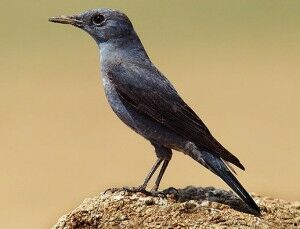 The Blue Rock Thrush (MT: Merill) is Malta’s national bird, although this species has quite an extensive range across the world. It breeds in southern Europe and northwest Africa, and from central Asia to northern China and Malaysia. The European, north African and southeast Asian birds are mainly resident birds (apart from altitudinal movements) while other Asian populations are more migratory.
The Blue Rock Thrush (MT: Merill) is Malta’s national bird, although this species has quite an extensive range across the world. It breeds in southern Europe and northwest Africa, and from central Asia to northern China and Malaysia. The European, north African and southeast Asian birds are mainly resident birds (apart from altitudinal movements) while other Asian populations are more migratory.
Its Latin (scientific) name refers to its preference for rocky habitats (monticola = mountain dweller) and also to the fact that it is not a gregarious species (solitarius = solitary).
The blue rock thrush is 20-23cm long and has a long slim bill. It nests in rock cavities and fortifications, particularly near the sea and usually lays 3-5 eggs. It is an omnivore and eats a wide variety of insects in addition to berries.
The summer male has a blue-grey plumage apart from its darker wings. Females and young are much less striking, with dark brown upperparts, and paler brown scaly underparts. The male blue rock thrush sings a clear, melodious call and can be frequently heard from late winter to early summer and again in autumn.
In Malta the Blue Rock Thrush is still a fairly common breeding resident, but the overall human interference has pushed the species mainly to the sea-cliff habitats. In the early years of the last century its population in Malta was already showing a very marked decrease. Although protected by law, the young are still frequently taken illegally from any accessible nests to raise in captivity, which is the main reason for this dramatic decrease.
Vagrant Hedgehog (Erinaceus algirus)
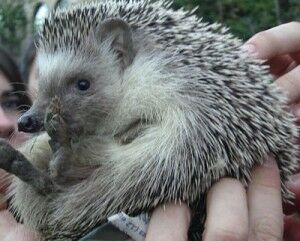
The Vagrant Hedgehog, or Algerian Hedgehog (MT: Qanfud), which grows to 20-25cm, is a terrestrial mammal having a head with a pointed snout, small round ears and a body covered by characteristic long, rigid and spiny hairs. Their spines are not poisonous or barbed and, unlike the quills of a porcupine, cannot easily be removed from the hedgehog. A common defense mechanism from predation that all species of hedgehogs possess is the ability to roll into a tight ball, causing all of the spines to point outwards.
It also has an acute sense of hearing and smell and feeds on snails, slugs, insects, worms and occasionally small vertebrates such as frogs and lizards. All hedgehogs are primarily nocturnal, although different species can be more or less likely to come out in the daytime. The hedgehog sleeps for a large portion of the daytime either under cover of bush, grass, rock or in a hole in the ground. Most wild hedgehogs can hibernate, although the one found in Malta does not, but is not active at temperatures below 20°C.
In Malta, this hedgehog is considered rare and is probably the only hedgehog found on our islands. Its habitat is restricted to the flat lands of the eastern Mediterranean coast where its numbers have been decimated by urban encroachment across the coastal plains, vehicles and dogs. Legally protected in Malta, NTM is now working to collect funds to set up Malta’s first wildlife clinic, where injured hedgehogs could also be rehabilitated.
Mediterranean Chameleon (Chamaeleo chamaeleon)
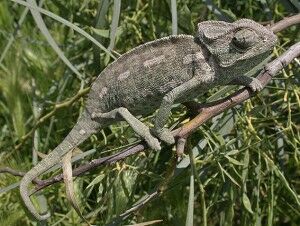
The Mediterranean Chameleon (MT: Kamaleonte) is not endemic to the Maltese Islands but was introduced in the 19th century by protestant missionaries who brought specimens over from North Africa and released them in the gardens of what is now the Jesuit college of St. Ignatius in St. Julians. It has now spread to all parts of Malta and is also found on Gozo.
It grows up to 30cm and is normally greenish or brown with paler markings. Its colours can turn lighter or darker and when threatened, besides changing colour, it puffs up its body and opens its mouth wide to appear larger and more fierce.
Although usually an arborial creature (lives only in trees) the female leaves the trees in order to lay eggs in a hole dug near the base of the trunk and then cover them in soil. Also, unusual is the fact that it is also quite common in garigue areas.
Painted Frog (Discoglossus pictus)
The Painted Frog (MT: Zring) is the only Maltese amphibian and grows to no more than 7cm. The colour of the frog is vary variable but the more common is olive-green to grey with a whitish ventral surface. It is found in areas where freshwater is present, whether flowing or stagnant but prefers shallow areas so it can rest in the water with head above the surface. In summer it lies concealed in damp places since the freshwater tends to evaporate, leaving a dry pool.
The female frog lays about 500 eggs in a layer held together by a gelatinous covering making the egg mass sticky and thus attaches to vegetation, stones or the sides or bottom of the pool of water they are in. Each egg grows to about 4mm and then hatches, releasing a tadpole characterised by its long tail. Tadpoles stay about 5-8 weeks in the water breathing through gills until lungs develop and metamorphosis into a frog occurs.
Moorish Gecko (Tarentola mauritanica)
The Moorish Gecko (MT: Wizgha tal-Kampanja) can measure up to 15 cm and is characterized by a brownish grey or brown robust body and a flat head. Its back, legs and tail have prominent conic tubercles; however its regenerated tail is smoother and doesn’t have tubercles. It is distinguishable from other geckos since only its third and fourth toes bear claws.
It is mainly nocturnal but can also be active during the day, particularly on sunny days at the end of winter. It is found living in rubble walls, on rocks, cliffs or disused buildings and walls of houses. They are carnivorous and hunt insects attracted to lights at night. They lay two near-spherical eggs twice a year between April and June and after four months young less than 5cm in length are born.
Turkish Gecko (Hemidactylus turcicus)
The Turkish Gecko (MT: Wizgha tad-Djar) can measure up to 10 cm and is characterized by a pale, translucent skin. All toes bear claws, unlike the Moorish gecko, in which only its third and fourth toes bear claws. It prefers warm places both near the coast and inland and is also found living in rubble walls, on rocks, cliffs or disused buildings and walls of houses. The Turkish gecko emerges at dusk when it hunts for insects and spiders. They lay two near-spherical eggs twice a year which hatch in 2-3 months.
Ocellated Skink (Chalcides ocellatus)
As an adult, the skink (MT: Xahmet l-Art) generally reaches about 30cm in length and is characterized by having a small head, a cylindrical body with black spots on its back and five toes on each foot. They are very agile and, when moving, crawls on its belly instead of using its short legs. It preys on various insects, including those with hard exoskeletons, arachnids, and small lizards, including its own young, of which 2-3 are produced each time. It is found on cultivated ground or in sandy localities where it hides in cracks at the base of walls or beneath stones.
Algerian Whip Snake (Coluber algirus)
The Algerian Whip Snake (MT: Serp Ahdar) is an ash grey to brown snake that grows up to 1m in length. It is characterised by having a darker head and dark bands on its back together with a whitish belly. It hunts small animals by day in dry, rocky habitats and also in disused buildings and piles of stones. It was probably introduced from North Africa by cargo ships since it is not endemic and not found elsewhere in Europe.
Western Whip Snake (Coluber viridiflavus)
The Western Whip Snake (MT: Serp Iswed) is the largest snake found on the Maltese Islands and grows up to 1.5m in length. It is black but often has a greenish tinge and its belly is light grey and sometimes yellowish. The young are usually pale ash-grey with an olive-green head until their fourth year, when they start to take on the adult colours. It is found mainly in dry areas among stones and vegetation, but is encountered in most habitats. It also climbs trees, and likes basking in the sun. It feeds on lizards together with smaller snakes, mice, frogs, young birds and large insects. Mating begins in March and the female lays 5-15 eggs in June or July, hatching occurs 6-8 weeks later.
Leopard Snake (Elaphe situla)
Growing up to 1m long the leopard snake (MT: Lifgha) is ash-grey to yellowish and has numerous black-bordered reddish brown spots. The eyes are also reddish. It is found mostly on the ground among stones and vegetation in garigue habitats and field verges. It is active by day, but is most often seen at dusk when it feeds on small animals. Only 2-7 eggs are laid per female snake.
Cat Snake (Telescopus fallax)
The cat snake (MT: Teleskopu), which grows up to 1m long is a slender ash-grey, brown or yellowish brown snake with darker markings and a broad, flattened head. Its eyes are characterized by a vertical pupil. It usually prefers areas with rocks and boulders, under which it retreats during the day. At dusk it emerges, hunting lizards and small mice. It is the only poisonous snake on the Maltese Islands, however its venom is weak and injected by the back teeth of upper jaw, thus only effective on small prey which can be swallowed whole. 7-8 eggs are laid per female.
Sicilian Shrew (Crocidura sicula)
The Sicilian Shrew (MT: Gurdien ta’ Geddumu Twil) is a small mouse like organism with a long, pointed snout and small eyes. It does not exceed 10-12cm in length (including the tail) and usually has a weight of just 4 to 9 grams. The fur on its back is a light gray colour, with some brownish patches while the underside of its body is an off-white colour. On the sides there is a clear distinction between the grey of its back and the white of its belly, a diagnostic feature of the species.
It is a terrestrial nocturnal species which often uses burrows dug by other mammals as shelters, but sometimes also simple cracks in rocks or amongst leaf litter. Shrews live in open scrubland and maquis, but also in some woodlands, particularly holm, cork and oak. It is a sharp predator that eats the equivalent of about 50-60% of its body weight per day. It has highly sensitive whiskers and a good sense of smell, compensating for its poor eyesight. It feeds mainly on arthropods and earthworms, but also on the carcasses of small vertebrates like rodents and reptiles.
Four subspecies exist with only one of them (Crocidura sicula ssp. calypso) being found on the Maltese Islands, more precisely on Gozo.
Lesser Horseshoe Bat (Rhinolophus hipposideros)
The Lesser Horseshoe Bat (MT: Farfett il-Lejl tan-Naghla Zghir), which grows to 4-5cm long (wingspan: 19-25cm), is the only horseshoe bat found in the Maltese Islands. They are so called due to the presence of horseshoe-like lobes on their faces which vary in form from one species to the next. They sleep hanging upside down with wings folded around the body and then set out about one hour after sunset, flying through most of the night hunting moths, mosquitoes, beetles and spiders. They are found all year round, usually singly but sometimes in small colonies. They remain dormant in the winter months and are usually found in deep caves.
Lesser Mouse-Eared Bat (Myotis blythi)
The Lesser Mouse-Eared Bat (MT: Farfett il-Lejl Widnet il-Gurdien) is one of the largest species of bats and grows between 6 and 7.5cm long, with a wingspan of 30 to 40cm. It is found all year round in some deep caves singly or in colonies of about 20, though colonies of 100 inidividuals were recorded in two localities. It flies out at dusk frequenting cultivated land, edges of woodland or areas around open water reservoirs. It feeds mainly on flying insects though it can also eat insects on the ground.
Grey Long-Eared Bat (Plecotus austriacus)
The Grey Long-Eared Bat (MT: Farfett il-Lejl Widnejh Kbar) grows up to between 4 and 5.5cm and a wingspan of between 25 and 30cm and is characterised by its very long ears, hence its name. It is found mainly near cultivated land and in inhabited areas where it sleeps in cracks in walls and in rock faces, or, in winter, in caves or tunnels where it remains in a dormant state. It is also nocturnal and feeds mainly on insects in flight. Females reach maturity in two years and in late June congregate in groups of about 10 to give birth, after which the young are tended to for 6-7 weeks.
Pipistrelle (Pipistrellus pipistrellus)
The Pipistrelle (MT: Pipistrell) is the smallest bat and most widespread in all of Europe. It grows only between 3.5 to 5 cm long with a wingspan of 18-24cm. Its ears are short and rounded while its wings are very slender. It is found in inhabited areas but also near valleys, cliffs and woodland and roosts in small groups in trees, walls, old houses and bastions. It flies out very soon after sunset catching small insects as it flies. It is thought that a single pipistrelle can consume up to 3500 mosquitoes in a single night. Females that reach maturity usually congregate in late spring to give birth with a small litter of just one (sometimes two) every two years. The young fly after about 20 days of birth. Males mate up with no more than 10 females.
Weasel (Mustela nivalis)
The weasel (MT: Ballottra) is the smallest organism in the whole group of carnivores (order Carnivora) and grows between 20-30cm (male) or 17-18cm (female). It is rather long and slender with short limbs, a long neck and a small head. Its fur is reddish-ginger with white belly fur, which is not always visible during the summer months.
It is found in all habitats and hunts both by day and by night, feeding on rodents, rabbits and nestlings. When food is plentiful, i.e. in April-May and July-August female weasels give birth to 4-6 young after a gestation period of 34-37 days. A characteristic mammalian feature is that the young are well looked after by the mother.
In the Maltese Islands the weasel is only found on the island of Malta, and is not found on Gozo and Comino.
Maltese Topshell (Gibbula nivosa)
The Maltese Topshell (MT: Gibbula ta’ Malta) grows to about 1cm in size and lives on Lesser Neptune Grass (Cymodocea nodosa). The ground colour is light brown with whitish patches. Many empty shells are found in the countryside and living specimens are not seen for a rather long time. This species is very rare and endemic to the Maltese Islands.
Maltese Door Snail (Lampedusa melitensis)
Two species of snail of the genus Lampedusa (Lampedusa imitatrix and Lampedusa melitensis) were isolated on the Maltese Islands and speciated. Lampedusa imitatrix is very limited in distribution whilst Lampedusa melitensis is now extremely threatened since it used to live on an upper coralline limestone plateau that fell and now forms part of the boulder scree characterizing the Dingli area. Lampedusa entered the islands when a land bridge joining Malta and Sicily was present and the door snail was allowed to cross from one land mass to another. Being so close to Sicily, conditions were just as favourable for Lampedusa and it thrived to large numbers.
However, after the rejoining of the two islands due to the reformation of the land bridge there was an invasion of another Sicilian door snail genus in the form of Muticaria. This genus, also made up of two species (Muticaria oscitans and Muticaria macrostoma), is more aggressive than Lampedusa since it is a stronger competitor and reproduces more readily. This led to Muticaria outcompeting the Lampedusa genus resulting in Muticaria thriving all over the islands while Lampedusa is restricted to the limits of Dingli and a few other areas scattered round Malta.
Maltese Field Beetle (Pimelia rugulosa ssp. melitana)
The Maltese Field Beetle (MT: Hanfusa tar-Raba’) is an insect that grows to about 16-20mm long and is often found in the countryside, particularly in coastal areas where it gnaws bases of plants. It is rather common and is endemic to the Maltese Islands.
Meadow Brown (Maniola jurtina ssp. hyperhispulla)
The Meadow Brown (MT: Kannella Kbir) is a butterfly found in European meadows, where its larvae feed on grasses. Characteristic of the species is the very pronounced sexual dimorphism. Males are much less colorful and have small eyespots and much reduced orange areas on the upper forewings. They are also more active and range far about, while females fly less and often not far from the area where they grew up.
Its size ranges from 24 to 30mm and appears between mid-April and early September. The subspecies hyperhispulla is very common and endemic to the Maltese Islands.
Swallowtail (Papilio machaon ssp. melitensis)
The Swallowtail (MT: Farfett tal-Fejgel) is a butterfly with yellow wings with black wing and vein markings and a wingspan of 8 to 10 cm. The hind wings of both sexes have a pair of protruding tails which give the butterfly its common name. Just below each tail is a red eye spot. It is commonly seen between February and November. The adult’s lifespan is about 20 days, during which the female lays its eggs on the flowers of rue and fennel, usually producing two broods and occasionally a third.






